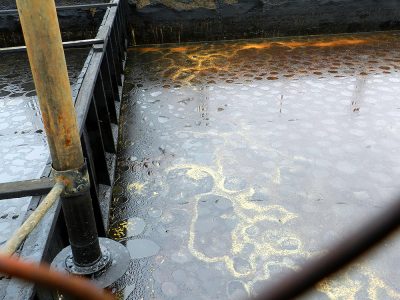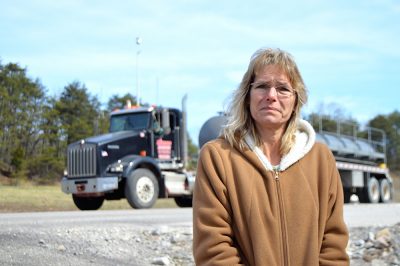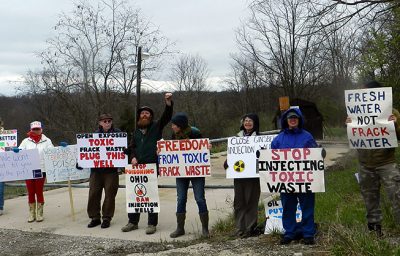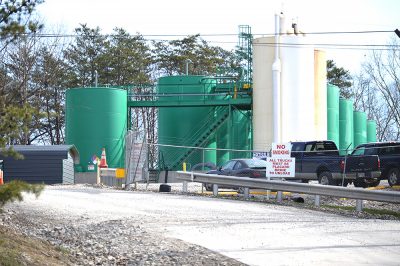Appalachia’s Toxic Dumping Ground

The abandoned Ginsburg injection well sits exposed to the elements in Athens, Ohio. The community organization Torch CAN DO is campaigning to close and plug the open pit. Photo by Roxanne Groff
Twenty-four hours a day, seven days a week the trucks stream through eastern Ohio’s rolling landscape along Highway 50. Most come from West Virginia and Pennsylvania. All bear a placard with the designation “BRINE,” which doesn’t begin to describe the toxic, radioactive liquid slipping past motorists.
Felicia Mettler, a local resident, counted 108 brine trucks in one 24-hour period in 2016 at the K&H fracking waste injection well site in Torch, Ohio. The town is so small it doesn’t have a grocery store, but it’s home to one of the largest injection well sites in the state.
The underground injection wells store waste produced during the process of fracking, a shale gas extraction technique that forces fluid laden with heavy metals and other contaminants underground to fracture rock and free trapped oil or natural gas.
The K&H site’s three wells received 2.16 million barrels of frack waste in 2016. That figure more than doubled to 4.42 million barrels in 2017.
Each barrel contains 42 gallons, making a staggering 185.57 million gallons injected last year at the K&H site alone. In total, Ohio dumped 36.26 million barrels in 2017, the equivalent of 2,307 Olympic-sized swimming pools. Roughly half of that was shipped from Pennsylvania and West Virginia.
According to the U.S. Environmental Protection Agency, there are more than 38,000 Class II disposal wells, which specifically take fracking waste. Most of these wells operate in Texas, California and Oklahoma, but Ohio is also among the top five states.
Ohio has minimal regulation and disposal fees — 20 cents per barrel for out-of-state waste and 5 cents for in-state. Once a well reaches 500,000 barrels, all subsequent waste is free.
“Ohio has become [Appalachia’s] dumping ground for toxic waste,” Mettler says. “Most of the [fracking] waste comes from out of state. West Virginia and Pennsylvania are where we get most of the waste from. It’s just sad that you hear people say, ‘Oh, Ohio, that’s the new toxic toilet bowl.”

Just the sight of the endless stream of trucks can be overwhelming at times for Torch, Ohio resident Felicia Mettler. “I cannot pull out on the highway without seeing all of these trucks and knowing that all of this toxic waste is coming to my community and there’s nothing that I can do about it!” she says. Photo by Lorelei Goff
The most recent figures calculated by the environmental group FracTracker Alliance show that Ohio has roughly 245 active Class II disposal wells and 35 proposed wells. Several hundred proposals to convert other wells to Class II wells are under consideration.
Pennsylvania, by contrast, currently operates five Class II wells but the state has approved additional wells and has other permits pending. As of 2016, West Virginia had 62 active Class II disposal wells.
Felicia Mettler doesn’t know exactly what’s in the waste. A clever use of patent law allows the oil and gas industry to keep the ingredients of fracking fluid a proprietary secret, and companies are exempted from certain federal regulations in the Clean Water Act, the Safe Drinking Water Act, the Superfund program and other environmental laws.
What is known is that fracking fluids can contain any of hundreds of toxic chemicals, heavy metals, corrosive salts and radioactive materials, many of which are carcinogenic and can cause genetic mutations or harm the central nervous system.
As the fluid is forced hundreds or thousands of feet into the Earth’s crust, it picks up salts — hence the designation “brine” — and radioactive particles from radium and radon.
According to the online water information site Water and Wastewater International, up to 60 percent of the brine then flows back up the fracking well shaft with the gas and is separated. The fluid is sometimes re-used, further concentrating it.
The waste is then transported to injection wells or landfills, and some is sold to highway departments to suppress dust or ice on roads.
The Local Price Of Corporate Profits
Before 2015, Felicia Mettler’s in-laws Phyllis and Ron Rienhart didn’t pay much mind to K&H, a facility with holding tanks and a guard shack just across the road. But when they started noticing loud noises, strange odors, tremors and unexplained ripples in their birdbath on windless days, the Rienharts suspected the K&H site might be the cause of the strange events.
They were shocked to learn that K&H was a frack waste injection site and was likely causing the tremors the Rienharts felt.
That’s when Mettler, who had previously been a strong supporter of fracking, became what she calls “an accidental activist.”
“I didn’t completely understand fracking,” Mettler says. “I just understood that we need gas and we need oil and so therefore I supported fracking. After learning about injection wells and frack waste and fracking, I immediately understood that this is not a good thing.”
“All of the laws surrounding frack waste and injection wells in the state of Ohio support the industry,” she adds. “They do not protect citizens.”
That realization left Mettler feeling like her community was being marginalized.
“We’re just country folk,” she says. “We don’t matter. We can be sacrificed. It’s horrible.”
The situation compelled the stay-at-home mom to found Torch CAN DO, which stands for Clean Air Now Defend Ohio, to educate others and push for better regulation of the industry.
Mettler is concerned about explosions, which have occurred after lightning struck wells in Oklahoma and Texas.
“Salt water shouldn’t explode,” Mettler says, referring to the fluid’s designation as brine. “Torch would be devastated.”
Ron Rienhart fears becoming an environmental refugee.
“My concern is, if this stuff starts coming up or one of these tanks over here blows up, are they going to contaminate this area to the extent that nobody can live here?” he asks. “Where does a little town go? We’ve got no options.”
K&H has been the source of several toxic spills. In 2015 — the same year that roughly 8,000 gallons of frack waste spilled in Vienna, Ohio, destroying two wetlands and a pond — 15 tons of contaminated soil was removed downhill from K&H after a spill there. Soil contaminated by frack waste is supposed to go to EPA-approved landfills.
Last November, a brine truck overturned a couple miles from the facility, dumping roughly 1,500 gallons of frack waste into a culvert that leads to White’s Run stream, which feeds the Ohio River.
Torch CAN DO member Suzie Quinn took water samples from the creek nine days after the spill had been cleaned up. Her tests showed that even after the cleanup, the culvert’s conductivity — a measure of salt and other contaminants — was about twice that of an upstream sample.
The seriousness of the spill was made clear when Quinn’s hand started burning after taking the samples. After profuse rinsing, it eventually faded to a tingling and stopped.
The group is also concerned about the area’s groundwater, especially since the state doesn’t monitor it.
In a June 2015 letter, Tuppers Plains-Chester Water District General Manager Donald Poole told the district’s customers it couldn’t adequately test for frack waste contamination because the utility doesn’t know what’s in the fracking brine. He sent a separate letter to the Ohio Department of Natural Resources to request disclosure of frack waste chemicals, but says the agency’s response was unsatisfactory. The district relies on six groundwater wells to supply drinking water to the area.
The lack of emergency preparedness plans for a fire, explosion or spill at K&H concerns Mettler, as does the lack of a notification system for area residents and first responders. Torch CAN DO and Buckeye Environmental Network applied in March for a grant to help establish a warning system.
One County, Eight Wells, Billions of Barrels
K&H isn’t the only injection well site in Athens County.
In 2017, the county ranked second in the state for the amount of frack waste it took in, according to figures compiled by the Buckeye Environmental Network. Neighboring Washington County ranked first.
That year, Athens County received 465,221 barrels of in-state fracking waste and over 4.72 million barrels from other states.
Mettler’s home is 10 miles downriver from the Atha injection well, which sits by a cornfield and across the road from the Hocking River, a tributary of the Ohio River. She estimates the storage tanks are located roughly 500 feet from the water.
A 40-minute drive away in Athens, Ohio, an open waste pit about the size of a backyard swimming pool sits at the now-idle Ginsburg injection well. A three-sided chain link fence with a chain strung between two posts is the only barrier to the wellhead, where machinery sits rusting amid overgrown weeds and grass.
It is one of two open pits out of the county’s eight total frack waste sites, six of which are in operation including the other open pit.
Though the metal-lined containment tank hasn’t received any waste for two years, the oily, acrid substance sits open to the air along the roadside in a residential area. Bert Ashcraft lives close to the Ginsburg site, where a state inspector told him to report any dying grass or leakage around the pit. Though he can smell it when the wind blows toward his house, he says he is not concerned because he believes it’s just salt water.
Asked if he would feel differently if he knew it contained hazardous chemicals, he says, “Maybe, if I knew more information about it, I might. If they’re labeling that as just brine, then that should be changed.”
Earth-Shaking Consequences
Charles Mansfield, a civil engineer, lives behind the Ginsburg pit. He says he is aware there have been “some minor earthquakes” since fracking started and that many people have voiced concerns about groundwater contamination.
“There’s faults and you can’t, without a lot of underground investigation, identify all the faults,” he says, adding that there is no danger of groundwater contamination because the water table only comprises the top 300 feet below ground and injection wells go 800 to 1,200 feet down.
“I hear it on the news all the time that they’re convinced that an injection well is going to contaminate drinking water,” Mansfield says. “The likelihood of that is very, very remote.”
Youngstown State University geologist Ray Beiersdorfer disagrees.
“They are drilling through the water table,” Beiersdorfer explains. “Industry’s own data shows that cement fails. If you have a well that is 30 years old, there’s a 50 percent chance that the well is going to fail and stuff can migrate [out of the wells].”
He adds, “Cement corrodes over time, particularly down deep underground where you have these caustic chemicals reacting with it. And quite often, right from the beginning on the vertical wells, there’s typically about a 6 percent failure rate where they don’t get a good seal with the cement.”
Beiersdorfer explains that the porosity of rock determines the ability of fluid to flow through rock.
“Sometimes a fault will actually seal things off but the broken-up rock in a fault zone will act as a conduit,” he says, noting that caverns allow fluid to migrate more quickly.
Beiersdorfer also says the earthquakes are more than a minor problem. This area of Ohio, which never experienced quakes prior to fracking and injecting, has had about a thousand since 2011, including a magnitude 4.
In December 2010, operators began injecting waste underground in the Northstar #1 well in Youngstown. The quakes began in January of 2011. For eight and half months, Beiersdorfer says, the Ohio Department of Natural Resources denied that they were related.
“My 80-year-old neighbor saw the connection,” he says. “My freshmen students saw the connection. There was a connection in time. There was a connection in space.”
He says state regulators finally succumbed to public pressure and had four portable seismometers set out to monitor the site in 2011. That Christmas Eve, it registered the 4.0 magnitude quake with an origin in close proximity to the bottom of the well. The Northstar #1 well was subsequently shut down. It caused more than 500 quakes, according to Beiersdorfer.
In the Niles-Weathersfield area of Trumble County, information about quakes was kept from the public, according to Beiersdorfer, until one large enough to register on the U.S. Geological Survey Regional Network occured in 2014. The public later learned that there had been 108, including a series of quakes on a second, pre-existing fault.
Beiersdorfer says the USGS determined that the amount of fluid injected is proportional to the amount of seismic energy that must be released. That energy could be released in a thousand tiny earthquakes or one or two big ones.
Beiersdorfer used the USGS model to calculate the earthquake potential in Brookfield, Ohio, where Pittsburgh-based Highland Field Services, LLC, recently began construction on five proposed injection wells next to a 250-unit mobile home community and the town’s fire department and EMS.
“You’re looking at a magnitude 5 earthquake potential,” he says. “To me, that throws up a red flag.” He adds that a previously attempted injection well in Brookfield drilled through an abandoned mine, after which the company halted construction and spent $100,000 to seal it. According to Beiersdorfer, the company never looked at an available map of mines.
“The regulatory agencies in this country have been captured by the industry they’re supposed to regulate,” he says. “Again, we had eight-and-a-half months of earthquakes in Youngstown and they were denying any connection between them all. Basically, in our case, they’ve changed the law. They’ve taken away local control and put it all with the Ohio Department of Oil and Gas.”
Felicia Mettler says she’ll continue fighting to change those laws to protect citizens from injection well hazards.
“My kids deserve clean water,” Mettler says. “They deserve air that they can breathe that’s not going to make them sick. They deserve a ground that’s safe to walk on, not man-made earthquakes. They deserve a better future.”
Correction: The print version of this article incorrectly described truck traffic on Highway 5 in Ohio. The online version has been corrected to note that it is Highway 50.
Fighting Back
Citizens and environmental groups have experienced successes and setbacks in opposing frack waste.

In Ohio, residents hold signs calling for the closure of the Ginsburg site and an end to frack waste disposal. Photo by Felicia Mettler
Ohio: In 2016, public pressure effectively stopped a Coast Guard proposal that would have permitted the shipping of frack waste on the Ohio River and other inland rivers and intercoastal waterways. According to a report by EcoWatch, more than 98 percent of the public comments submitted were opposed to the plan. More than 100 organizations pressed the Coast Guard to drop the proposal.
West Virginia: In August, a federal appeals court rejected the effort of Fayette County, W.Va., officials to institute a ban on frack waste disposal in the county. The court ruled that state legislation precludes the rights of counties to enact bans contrary to permits granted by the state. The county implemented the ban after citizens and officials found cause for concern regarding potential drinking water contamination.
New York: Beginning in 2011, more than 100 communities in New York implemented bans on fracking and storage of frack waste, using home rule to trump more lax state laws, according to Karen Edelstein with FracTracker, an environmental group that tracks the fracking industry. “That’s turned out to be a pretty good thing because there’s a fair amount of conventional, and probably unconventional, fracking waste that is sent to New York state for road spreading,” says Edelstein. The governor of New York implemented a statewide ban on high-volume hydraulic fracking in 2014.
Across the Nation: On May 14, a Permanent Peoples’ Tribunal Session on Human Rights, Fracking and Climate Change will convene in Oregon to formulate advisory opinions as to whether lawmakers have disregarded human rights in allowing fracking and injection wells. The international, independent human rights tribunal will take the findings to several United Nations organizations. Preliminary tribunals were held in Athens and Youngstown, Ohio, Charlottesville, Va., and Australia. “This is the first time in a year that I’ve felt like there is some hope,” says Felicia Mettler, a Torch, Ohio resident and founder of Torch CAN DO, a co-sponsor of the tribunals. “I am hoping that the United Nations will be able to step in and slow this down, stop this, and examine this better.”
Kentuckians Advocate for Removal of Illegal Waste in Landfill
The Concerned Citizens of Estill County, Ky., held a public forum on Feb. 12 to discuss waste collection company Advanced Disposal’s proposed plan to contain radioactive waste illegally dumped in the Blue Ridge Landfill in Irvine.
Approximately 47 truckloads of oil and gas production waste from West Virginia, and additional oil production waste from Ohio, was dumped in the landfill in 2015, according to an agreed order between Advanced Disposal and the Kentucky Energy and Environmental Cabinet.
The forum was held the day after the 30-day comment period on Advanced Disposal’s proposal ended. At the meeting, the citizens group announced that it submitted a plan to the cabinet advocating for the waste’s removal.
“It’s unjust to now burden this community with this uncertain level of risk going forward,” Mary Cromer, an Appalachian Citizens Law Center attorney working with the Estill County group, said at the forum.
Advanced Disposal’s proposed plan would leave the radioactive material in place with a temporary cap, radionuclide monitoring and moving methane wells. Their alternative plan, preferred by the citizens group, would require moving the waste to a more suitable landfill in Pennsylvania, an action Advanced Disposal says may pose health risks to workers and community members. — By Ashley Goodman
Related Articles
Latest News

Leave a comment
Your email address will not be published. Required fields are marked *






Leave a Comment